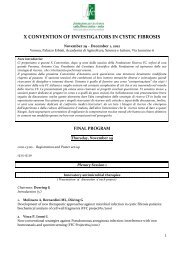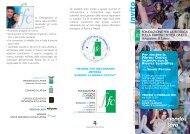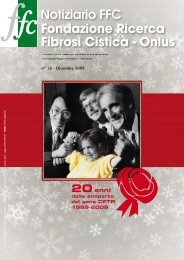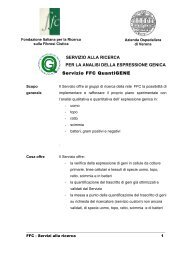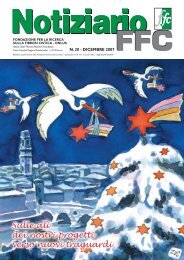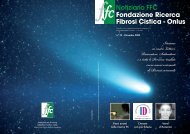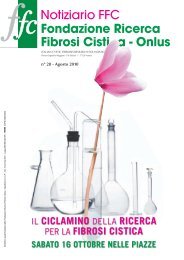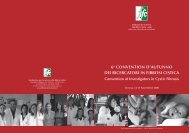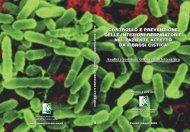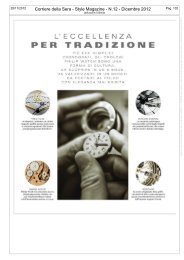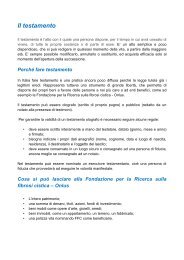Brochure Seminario di Primavera 2005 - Fondazione Ricerca ...
Brochure Seminario di Primavera 2005 - Fondazione Ricerca ...
Brochure Seminario di Primavera 2005 - Fondazione Ricerca ...
Create successful ePaper yourself
Turn your PDF publications into a flip-book with our unique Google optimized e-Paper software.
MSCs could be localized to the lung, bone, and<br />
cartilage for as long as five months post-transplant.<br />
Jiang et al. (2002) demonstrated that adult<br />
MSCs <strong>di</strong>fferentiate into all three germ layers and<br />
tissue-specific cell types inclu<strong>di</strong>ng airway epithelium,<br />
when injected into an early blastocyst. It has<br />
also been documented that adult mouse MSCs <strong>di</strong>fferentiated<br />
into type I pneumocytes in bleomycin<br />
injured lungs (Kotton et al. 2001). In a more recent<br />
study, Ortiz and colleagues demonstrated that<br />
MSCs traffic to the lung in response to injury with<br />
bleomycin, adopt an epithelium cell-like morphology,<br />
and promote the reduction of bleomycininduced<br />
inflammation and collagen deposition<br />
(Ortiz et al., 2003). Recently, human MSCs have<br />
identified to <strong>di</strong>fferentiate into cells that morphologically<br />
resemble airway epithelial cells and to<br />
express epithelial-specific genes as they <strong>di</strong>fferentiate<br />
(Spees et al., 2003). In a <strong>di</strong>fferent setting,<br />
Grove et al (2002) transplanted retrovirus-transduced<br />
bone marrow stem cells into sublethally<br />
irra<strong>di</strong>ated mice. They found that the donor stem<br />
cells repopulated in the lung and <strong>di</strong>fferentiated<br />
into lung epithelium. These results suggest the<br />
pluripotency of mesenchymal stem cells, in<strong>di</strong>cating<br />
that adult MSCs have the potential for therapy<br />
of lung <strong>di</strong>seases.<br />
In my laboratory, we tested the hypothesis that<br />
MSCs from CF patients can be isolated, expanded<br />
and gene-corrected, and the gene-corrected CF-<br />
MSCs have the ability to correct the CF-associated<br />
Cl- secretion defect by functionally transporting<br />
this anion to the apical side (Wang et al., <strong>2005</strong>). We<br />
first co-cultured human MSCs with primary human<br />
airway epithelial cells at the air-liquid interface.<br />
Expression of epithelia-specific genes, such as<br />
14<br />
CELLULE STAMINALI<br />
cytokeratin 18 and occlu<strong>di</strong>n, was induced, suggesting<br />
that under such a co-culture con<strong>di</strong>tion, MSCs<br />
<strong>di</strong>fferentiated into epithelium. Furthermore, we<br />
isolated MSCs from several CF patients. The CF-<br />
MSCs were amenable to CFTR gene correction. The<br />
CFTR-corrected CF-MSCs still retain their potential<br />
of <strong>di</strong>fferentiating into osteoblasts, a<strong>di</strong>pocytes and<br />
chondroitcytes. Importantly, the gene-corrected<br />
CF-MSCs can contribute to the apical chloride<br />
secretion in response to cAMP stimulation. These in<br />
vitro results proved the principle of using MSCs for<br />
the treatment of CF.<br />
Stem cell for CF therapy: challenges<br />
and future perspectives<br />
Even though the in vitro results look promising and<br />
marrow stem cells have the potential, this<br />
approach is still at the very early research stage.<br />
Three major issues would have to be resolved<br />
before any clinical trial attempts: 1) how to efficiently<br />
recruit CFTR-gene-corrected stem cells to<br />
the lung? 2) how to efficiently induce the genecorrected<br />
stem cells to <strong>di</strong>fferentiate into lung<br />
epithelial cells to achieve therapeutic effects in<br />
vivo? 2) how to safely gene-correct stem cells from<br />
CF patients? Basic research on stem cell biology<br />
and stem cell engineering is critical to improve our<br />
understan<strong>di</strong>ng of the underlying cellular mechanisms<br />
for stem cell <strong>di</strong>fferentiation and to achieve<br />
<strong>di</strong>rectional stem cell homing and engraftment to<br />
CF lungs. Methods to functionally test stem cell<br />
<strong>di</strong>fferentiation in CF lungs need to be developed. A<br />
suitable animal model is also needed to test the<br />
stem cell-based approach.<br />
References<br />
Grove, J. E. et al. Marrow-derived cells as vehicles for delivery of gene therapy to pulmonary epithelium. Am J Respir Cell Mol<br />
Biol 27, 645-51 (2002).<br />
Jiang, Y. et al. Pluripotency of mesenchymal stem cells derived from adult marrow. Nature 418, 41-9 (2002).<br />
Kotton, D. N. et al. Bone marrow-derived cells as progenitors of lung alveolar epithelium. Development 128, 5181-8 (2001).<br />
Krause, D. S. et al. Multi-organ, multi-lineage engraftment by a single bone marrow-derived stem cell. Cell 105, 369-77<br />
(2001).<br />
Ortiz, L. A. et al. Mesenchymal stem cell engraftment in lung is enhanced in response to bleomycin exposure and ameliorates<br />
its fibrotic effects. Proc Natl Acad Sci U S A 100, 8407-11 (2003).<br />
Pereira, R. F. et al. Marrow stromal cells as a source of progenitor cells for nonhematopoietic tissues in transgenic mice with<br />
a phenotype of osteogenesis imperfecta. Proc Natl Acad Sci U S A 95, 1142-7 (1998).<br />
Pittenger, M. F. et al. Multilineage potential of adult human mesenchymal stem cells. Science 284, 143-7 (1999).



